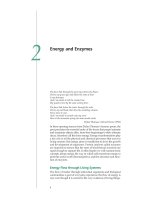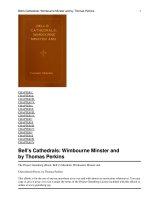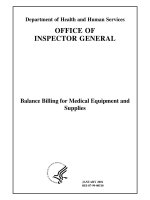Tài liệu Balance Billing for Medical Equipment and Supplies docx
Bạn đang xem bản rút gọn của tài liệu. Xem và tải ngay bản đầy đủ của tài liệu tại đây (235.89 KB, 23 trang )
Department of Health and Human Services
OFFICE OF
INSPECTOR GENERAL
JANUARY 2001
OEI-07-99-00510
Balance Billing for Medical Equipment and
Supplies
OFFICE OF INSPECTOR GENERAL
The mission of the Office of Inspector General (OIG), mandated by Public Law 95-452, as
amended by Public Law 100-504, is to protect the integrity of the Department of Health and
Human Services programs as well as the health and welfare of beneficiaries served by them. This
statutory mission is carried out through a nationwide program of audits, investigations,
inspections, sanctions, and fraud alerts. The Inspector General informs the Secretary of program
and management problems and recommends legislative, regulatory, and operational approaches to
correct them.
Office of Evaluation and Inspections
The Office of Evaluation and Inspections (OEI) is one of several components of the Office of
Inspector General. It conducts short-term management and program evaluations (called
inspections) that focus on issues of concern to the Department, the Congress, and the public. The
inspection reports provide findings and recommendations on the efficiency, vulnerability, and
effectiveness of departmental programs.
OEI's Kansas City office prepared this report under the direction of Brian T. Pattison, Deputy
Regional Inspector General. Principal OEI staff included:
REGION
Tricia Fields, Project Leader
Michael Craig, Program Analyst
Zula Crutchfield, Program Analyst
Joe Penkrot, Team Leader
Elander Phillips, Program Inspections Assistant
Marco Villagrana, Program Analyst
Deborah Walden, Team Leader
HEADQUARTERS
Stuart Wright, Director, Medicare and
Medicaid Branch
Barbara Tedesco, Mathematical Statistician
Scott Horning, Program Analyst
To obtain copies of this report, please call the Kansas City Regional Office at (816) 426-3697.
Reports are also available on the World Wide Web at our home page address:
EXECUTIVE SUMMARY
PURPOSE
To determine the effects and level of Medicare beneficiary awareness of balance billing for
durable medical equipment and supplies.
BACKGROUND
Part B of the Medicare program covers outpatient services and items, including durable
medical equipment, prosthetics, orthotics, and supplies (DMEPOS). Under Medicare Part
B, physicians and suppliers submit both assigned and non-assigned claims for these
services and items. For assigned claims, physicians and suppliers agree to accept the
amount allowed by Medicare as full payment. Medicare pays 80 percent of this amount
directly to the physician or supplier and the beneficiary pays 20 percent (plus any
outstanding deductible). In non-assigned claims, the physician or supplier bills the
beneficiary for the total charge for the service or item provided, which can exceed the
amount allowed by Medicare. Medicare pays the beneficiary 80 percent of the allowed
amount; the beneficiary pays all remaining charges. We define balance billing as the
portion of the charge in excess of the Medicare allowed amount.
Participating physicians and suppliers may voluntarily enter into an agreement to submit
assigned claims for all services and items provided to Medicare beneficiaries.
Non-participating physicians and suppliers may submit assigned or non-assigned claims on
a case-by-case basis. Physicians may not balance bill in excess of 115 percent of the
allowed physician fee schedule amount. However, no such limitations exist on balance
billing by suppliers.
We reviewed a random sample of non-participating suppliers and non-assigned claims.
We conducted telephone surveys with beneficiaries and mail surveys with suppliers. We
asked beneficiaries questions about selecting their supplier, awareness of the difference
between assigned and non-assigned claims and participating and non-participating
suppliers, and if they compared prices and services among suppliers. Questions we asked
suppliers include reasons they choose not to be a participating Medicare supplier and
factors that determine whether to accept assignment.
FINDINGS
Beneficiaries Paid $41 Million Above the Medicare Allowed Amounts for Medical
Equipment and Supplies
As stated above, there is no limitation on balance billing by suppliers as there is for
physicians. Medicare beneficiaries faced balance billing liabilities of approximately
Balance Billing for DMEPOS
i
OEI-07-99-00510
$41 million, $30 million of which was above 115 percent of the Medicare allowed
amounts (the limit that applies to physicians), from nearly 3 million non-assigned
DMEPOS claims submitted in 1999. These claims comprise 5 percent of the number and
3 percent of the dollar amount of medical equipment and supply claims overall. Medicare
beneficiaries with recurring (as opposed to one-time) needs were responsible for roughly
twice the costs on non-assigned claims than those with assigned claims. For these
beneficiaries, medical equipment and supplies are recurring expenses which may be
incurred for the remainder of their lives. For non-assigned claims, suppliers usually
require Medicare beneficiaries to pay upon delivery. One-third of surveyed beneficiaries
do not have supplemental insurance that might pay for some portion of out-of-pocket
expenses for these items.
Most Surveyed Beneficiaries Are Unaware of Differences in Assigned and
Non-assigned Claims and Participating and Non-participating Suppliers
Only two out of every five beneficiaries know that if they choose a participating supplier
or a supplier that accepts assignment on a particular item, they pay only the outstanding
deductible and 20 percent co-insurance. Few beneficiaries select their DMEPOS supplier
based on cost considerations.
Sixty-two Percent of Suppliers Are Not Participating Medicare Suppliers
More than half of the suppliers surveyed state that low reimbursement is a reason they
choose not to be a participating Medicare supplier. Furthermore, 42 of these
100 suppliers also state that reimbursement levels are below cost on certain supplies.
Ostomy supplies were specifically identified by surveyed suppliers as a category of items
with low or below cost reimbursement. Based on a review of 1999 claims data, we found
that ostomy supplies have a higher non-assigned rate than supplies overall.
RECOMMENDATIONS
In order to increase beneficiary access to participating suppliers and reduce financial liability for
DMEPOS, we make the following recommendations to HCFA.
Educate Beneficiaries on Ways to Reduce Financial Liability
We recommend that HCFA educate beneficiaries on the options and consequences of
assigned and non-assigned claims and purchasing medical equipment and supplies from
participating and non-participating suppliers. We suggest, for example, that HCFA direct
the durable medical equipment regional carriers (DMERCs) to send an annual notice to
Medicare beneficiaries for whom a non-assigned claim was submitted containing an
explanation of assigned and non-assigned claims, participating and non-participating
suppliers, and the availability of the Medicare Participating Suppliers Directory. Another
suggestion is that HCFA direct the DMERCs to add a notation to the Medicare Summary
Notice on non-assigned claims that the beneficiary may be able to reduce their financial
Balance Billing for DMEPOS
ii
OEI-07-99-00510
liability for medical equipment and suppliers by purchasing from a supplier that accepts
assignment on the item.
Re-evaluate Medicare Fee Schedules for Ostomy Supplies
We recommend that HCFA re-evaluate the Medicare fee schedules for ostomy supplies.
After receiving survey responses from 15 suppliers stating that reimbursement is very low
or below cost for ostomy supplies, we conducted an analysis of 1999 claims data for these
supplies. We found that ostomy supplies have a higher rate of non-assignment than
DMEPOS overall, and also have a high percentage of claims submitted in excess of
115 percent of the allowed amount.
Other Considerations
We offer to HCFA other suggestions that could help decrease beneficiary financial liability
for medical equipment and supplies. However, these would require additional study and
analysis. They include exploring ways of increasing the participation rate of suppliers,
increasing beneficiary access to suppliers, and developing legislation to limit balance billing
on medical equipment and supplies.
AGENCY COMMENTS
HCFA concurred with our recommendations. HCFA stated that they have undertaken a
number of efforts to increase beneficiary education and awareness about the consequences
of assigned and non-assigned claims. HCFA also stated that the Participating Physician
Directory is available online, and that directory will be expanded in 2001 to include
supplier information.
HCFA stated that it will continue to explore options to increase beneficiary awareness.
We suggest that HCFA consider, as one of these options, a more direct approach to reach
Medicare beneficiaries who purchase medical equipment and supplies from
non-participating suppliers that submit non-assigned claims, such as an annual notice
and/or a notation on the Medicare Summary Notice for a non-assigned claim.
HCFA stated that it is committed to examining the payment for ostomy supplies once it
has published a final rule concerning its inherent reasonableness authority. We note that
HCFA could evaluate the appropriateness of the fee schedules while waiting for the
issuance of the final rule.
Balance Billing for DMEPOS
iii
OEI-07-99-00510
TABLE CONTENTS OF
PAGE
EXECUTIVE SUMMARY i
INTRODUCTION 2
FINDINGS
Beneficiaries Paid $41 Million in Balance Billing 6
Beneficiaries Unaware of the Differences 9
Majority of Suppliers Are Not Participating 9
RECOMMENDATIONS 12
APPENDICES
A: Confidence Intervals for Key Estimates 15
B: Agency Comments 16
Balance Billing for DMEPOS
1
OEI-07-99-00510
INTRODUCTION
PURPOSE
To determine the effects and level of Medicare beneficiary awareness of balance billing for
durable medical equipment and supplies.
BACKGROUND
Part B of the Medicare program covers outpatient services and items, including durable
medical equipment, prosthetics, orthotics, and supplies (DMEPOS). DMEPOS include
medical equipment and supplies such as wheelchairs, hospital beds, catheters, ostomy and
wound care supplies, and enteral and parenteral nutrition. In 1999, Medicare Part B paid
an estimated $6.2 billion for medical equipment and supplies.
Suppliers
Medicare only pays for DMEPOS that are prescribed or ordered by a physician. The
Medicare beneficiary then selects a supplier from which to rent or purchase the item.
Types of suppliers include: discount retail chains such as Wal-Mart, home medical
equipment businesses and pharmacies, and mail order companies. Suppliers can be large
corporations or small proprietorships. Some suppliers sell only medical equipment and
supplies, while others sell a wide variety of merchandise of which DMEPOS comprise a
small percentage of total sales for the retailer.
Assigned and Non-assigned Claims
Under Medicare Part B, suppliers submit both assigned and non-assigned claims. For
assigned claims, suppliers agree to accept the amount allowed by Medicare as full
payment. Medicare pays 80 percent of this amount directly to the supplier and the
beneficiary pays 20 percent plus any outstanding deductible. In non-assigned claims, the
supplier bills the beneficiary for the total charge for the service or item provided, which
can exceed the amount allowed by Medicare. In 1999, 5 percent of DMEPOS claims
were submitted non-assigned, equating to approximately 3 million claims and allowed
charges of $160 million. For these claims, Medicare pays the beneficiary 80 percent of the
allowed amount, less any deductible not yet met. The beneficiary must pay the supplier
directly the amount billed irrespective of the allowed amount. We define balance billing as
the portion of the charge in excess of the Medicare allowed amount.
Durable Medical Equipment Regional Carriers
In October 1993, the Health Care Financing Administration (HCFA) began processing
Part B claims for medical equipment and supplies through four durable medical equipment
regional carriers (DMERCs). Each DMERC processes durable medical
Balance Billing for DMEPOS
2
OEI-07-99-00510
equipment claims for a specific geographic region and ensures that all coverage
requirements for medical equipment and supplies are met before approving payment. Any
HCFA directives to change payment processing for DMEPOS claims are implemented
through the DMERCs.
Medicare Participation Program
The Deficit Reduction Act of 1984 established a participating physician and supplier
program for Medicare Part B, under which a physician or supplier may choose whether or
not to become a “participating” Medicare physician or supplier on an annual basis.
Participating physicians and suppliers voluntarily enter into an agreement to accept
assignment for all services and items they provide to Medicare beneficiaries.
Non-participating physicians and suppliers may submit assigned or non-assigned claims on
a case-by-case basis, but must accept assignment whenever a Medicare beneficiary also
has Medicaid coverage.
Each DMERC publishes a Medicare Participating Suppliers Directory (MEDPARD)
which lists the name, business address, and telephone number for each participating
supplier in its region.
Limiting Charges and Balance Billing
Currently, physicians who are non-participating Medicare physicians receive only
95 percent of the Medicare allowed amount; however, they may bill up to 115 percent of
this amount. This limit protects Medicare beneficiaries from excessive balance billing on
non-assigned claims. As of January 1999, 85 percent of physicians billing Medicare were
participating physicians.
Suppliers are not subject to limits on balance billing for medical equipment and supplies.
There are no limits on the amount suppliers can charge beneficiaries, nor is there a
reduction in payments to non-participating suppliers.
Payment for Upgraded Equipment
While Medicare will pay for items that are adequate and effective to meet the medical
needs of the beneficiary, it will not pay extra for convenience or luxury features. For
example, Medicare will pay for eyeglass frames, wheelchairs, and hospital beds which
meet the medical needs of the beneficiary. However, Medicare will not pay for upgraded
versions that cost in excess of Medicare allowed amounts for items such as premium
eyeglass frames and total electric hospital beds.
Currently, a participating Medicare supplier or a supplier that accepts assignment on the
item must accept the allowed amount as full payment for the upgraded item. If a supplier
wishes to charge and collect a greater price for upgraded DMEPOS, they must be a
non-participating supplier and submit a non-assigned claim. Medicare then pays the
beneficiary 80 percent of the allowed amount, less any outstanding deductible. The
Balance Billing for DMEPOS
3
OEI-07-99-00510
beneficiary is then responsible to the supplier for the full payment price of the upgraded
item.
On April 27, 2000, HCFA issued a proposed rule for comment regarding the payment
procedure for upgraded equipment. The proposed rule would amend the Medicare
regulations to permit suppliers to furnish upgrades while still submitting an assigned claim.
Medicare would pay the supplier the allowed amount for the standard item less
20 percent co-insurance and any outstanding deductible, and the beneficiary would pay the
difference between the supplier’s charge for the upgraded item and 80 percent of the
allowed amount for the standard item.
METHODOLOGY
To determine the effects and level of Medicare beneficiary awareness of balance billing,
we reviewed non-participating suppliers and non-assigned claims. We selected a stratified
random sample of 150 (plus 150 spares) non-assigned DMEPOS claims from a 1 percent
sample of the Medicare Part B National Claims History file for the period September 1 -
November 30, 1999. This gave us a sample of beneficiaries along with the suppliers that
provided medical equipment or supplies to these beneficiaries.
We contacted beneficiaries or their caregivers associated with 150 claims.
1
As shown in
the table on the following page, we chose 50 of the claims with the submitted amount
between 101 and 115 percent of the allowed amount. The remaining 100 claims had the
submitted amount in excess of 115 percent of the allowed amount. The 115 percent
threshold was chosen because it is the limit in effect for physician services. We chose a
larger sample size for claims submitted in excess of 115 percent of the allowed amount
because these items were of greater interest in our study.
1
We used 23 spares in stratum 1 and 60 spares in stratum 2 to replace beneficiaries that did not respond
after multiple attempts to contact them. We also replaced seven claims that were identified as assigned
claims during the survey process.
Balance Billing for DMEPOS
4
OEI-07-99-00510
Strata Non-
Universe of
assigned
claims
claims in 1
Number of
percent file
Claim
Supplier-
Combinations
Size
Sample
1. Claims for procedure codes for
which the submitted amount is
between 101% and 115% of the
Medicare allowed amount
601,090 1,198 100 50
2. Claims for procedure codes for
which the submitted amount is in
excess of 115% of the Medicare
allowed amount
1,117,839 2,213 200 100
Some beneficiaries had more than one claim in the sample. Therefore, we surveyed
138 different beneficiaries or caregivers, representing 150 claims. We asked the
beneficiaries and caregivers questions regarding the reasons they selected their supplier,
their awareness of the difference between assigned and non-assigned claims and
participating and non-participating suppliers, and whether they compared prices and
services among suppliers. We also asked about the method of payment for their supply or
equipment, how often they purchased it, and whether it was a recurring expense for the
beneficiary.
Out of 300 supplier-claim combinations, 27 claims were dropped for administrative
reasons; for example, some claims were submitted by beneficiaries that received their
DMEPOS from suppliers that do not possess a Medicare provider identification number
(some beneficiaries choose to purchase from suppliers that do not have the capacity to bill
Medicare directly). We surveyed the remaining sample of 273 supplier-claim
combinations by mail and received 216 responses (79 percent) representing 176 unique
suppliers. We asked questions on the type of equipment and supplies provided, the
reasons the supplier chose not to be a participating Medicare supplier, and factors that
determined whether to accept assignment on a particular claim. We also asked the
suppliers to estimate the percentage of claims they bill non-assigned and requested copies
of supplier billing and payment information for the sample of beneficiary claims to
determine the amount balance billed to the beneficiary and the amount collected by the
supplier.
We systematically analyzed the survey responses from Medicare beneficiaries and medical
equipment suppliers. We calculated confidence intervals for seven key estimates in the
report. The point estimate and 95 percent confidence interval for each estimate are listed
in Appendix A of this report.
We conducted this inspection in accordance with the Quality Standards for Inspections
issued by the President’s Council on Integrity and Efficiency.
Balance Billing for DMEPOS
5
OEI-07-99-00510
FINDINGS
Beneficiaries paid $41 million above the Medicare allowed
amounts for medical equipment and supplies
Medicare beneficiaries experience greater financial liability on non-assigned claims than
assigned claims because suppliers can bill more than the Medicare allowed amount on non-
assigned claims. There is no limitation on balance billing by suppliers as there is for
physicians. Projected from claims in the 1999 1 percent file, Medicare beneficiaries faced
balance billing liabilities of approximately $41 million, $30 million of which was above 115
percent of the Medicare allowed amounts (the limit that applies to physicians), from nearly
3 million non-assigned DMEPOS claims. These claims comprise 5 percent of the number
and 3 percent of the dollar amount of medical equipment and supply claims overall.
High volume, low cost items predominate
We arrayed the non-assigned claims in the 1 percent file from highest to lowest frequency.
The table below identifies the items comprising the top 50 percent of claims in terms of
frequency along with the total and average amount suppliers balance billed for these items.
Projected to the universe of non-assigned claims, the five items account for 22 percent of
the total amount balance billed in 1999.
Top 50 Percent of Claims Frequency
Projected from the 1999 1 Percent File
2
Item HCFA
Billing
Code
Number
of Claims
Total Balance Billing Average Balance
Billing per Claim
Glucose testing strips A4253 887,000 $3,152,708 $3.55
Bifocal lenses V2203 154,400 $1,952,556 $12.65
Lancets A4259 148,900 $178,270 $1.20
Ostomy wafers
(protective skin
barrier)
A5123 134,500 $735,852 $5.47
Eyeglass frames V2020 114,400 $3,137,511 $27.43
2
The frequency and dollar projections are based on the billing codes submitted for the claims. Multiple
HCFA billing codes exist for items similar to the above (e.g., additional billing codes exist for bifocal
lenses).
Balance Billing for DMEPOS
6
OEI-07-99-00510
Few claims have high balance billing
We also arrayed the non-assigned DMEPOS claims based on highest average balance
billing per claim. Projected to the universe of non-assigned claims, these 6,100 claims
account for $4,919,524 in balance billing, or 12 percent of the total dollars balance billed
for claims submitted in 1999. The table below identifies the items balance billed in excess
of $500 in terms of frequency along with the total and average amount suppliers balance
billed for these items.
Claims Balance Billed in Excess of $500
Projected from the 1999 1 Percent File
Item HCFA Billing
Code
Number of
Claims
Total Balance
Billing
Average Balance
Billing per
Claim
Desferal injection,
(deferoxamine
mesylate)
J0895 500 $995,120 $1,990.24
Flolan injection,
(epoprostenol)
J1325 1,000 $172,440 $1,724.40
Oxygen
concentrator
E1404 600 $694,270 $1,157.12
Above knee
prosthetic
L5320 100 $109,093 $1,090.93
Power operated
vehicle
E1230 1,800 $1,575,922 $875.51
Prosthetic eye V2623 1,000 $804,621 $804.62
Infusion pump for
epoprostenol
K0455 100 $67,253 $672.53
Motorized
wheelchair with
programmable
controls
K0011 1,000 $500,805 $500.81
Note: This table, like the previous one, is based on a simple projection of the 1 percent file. Some
estimates are based on a very small number of claims.
Sampled claims reflect the universe
Our sample is reflective of the universe of DMEPOS claims with balance billing. Over
one-half of our claims have balance billing amounts under $10. The table on the next page
shows the amount of balance billing per claim for the 150 claims in our sample.
Balance Billing for DMEPOS
7
OEI-07-99-00510
Amount of Balance Billing per Claim Number of Claims in
Sample
Distribution of Claims
less than $5 60 40%
between $5 and $10 25 17%
between $10 and $20 34 23%
between $20 and $50 20 13%
between $50 and $100 6 4%
between $100 and $200 4 3%
greater than $300 1 less than 1%
Total 150 100%
Most non-assigned claims are for recurring needs
In our survey, we asked beneficiaries to identify the claim(s) as either a one-time or
recurring expense. We found that 84 percent of non-assigned claims are for recurring
needs. Beneficiaries for 35 percent of these recurring non-assigned claims report ordering
the item monthly or more frequently. Examples of these items include ostomy supplies
and diabetic testing supplies. For these beneficiaries, these supplies are recurring
expenses which may be incurred for the remainder of their lives.
Medicare beneficiaries with recurring needs are responsible for roughly twice the costs on
non-assigned DMEPOS claims than the beneficiaries with assigned claims. The average
financial liability per claim for non-assigned recurring claims is $16.73. If these claims had
been assigned, the beneficiaries would have had an average of $8.50 financial liability. At
a minimum, this amounts to $98.73 more per year financial liability per claim for these
beneficiaries. Each beneficiary, on average, had responsibility for
39 percent of the allowed amount per claim, as opposed to 20 percent liability (plus any
outstanding deductible) on the allowed amount for an assigned claim.
Examples of items for the remaining 16 percent of non-assigned claims that beneficiaries
identified as a one-time expense include eyeglass frames and lenses, breast prostheses, and
walkers. While we did not ask the beneficiaries whether or not they considered these
items to be “upgraded,” eyeglass frames and lenses and ambulatory aids such as walkers
have the potential to include convenience or luxury features.
Suppliers expect immediate payment from Medicare beneficiaries
Beneficiaries experience a lag time in reimbursement from Medicare and supplemental
insurance companies for non-assigned claims. However, for non-assigned claims,
suppliers commonly require Medicare beneficiaries to pay for DMEPOS upon delivery.
The beneficiary then awaits reimbursement from Medicare and any supplemental
Balance Billing for DMEPOS
8
OEI-07-99-00510
insurance companies. One-third of surveyed beneficiaries report that they do not have
supplemental insurance that might pay some portion of out-of-pocket expenses
(e.g., co-insurance and deductible) for DMEPOS.
Most surveyed beneficiaries are unaware of differences in
assigned and non-assigned claims and participating and
non-participating suppliers
Because Medicare beneficiaries are unaware of the differences in assigned and
non-assigned claims and participating and non-participating suppliers, they may not
understand the financial consequences of their decisions. Only 44 percent of beneficiaries
we surveyed know there are differences in financial liability between assigned and non-
assigned claims. Only 41 percent know that if they choose a participating supplier or a
supplier that accepts assignment on a particular item, they pay only 20 percent co-
insurance, plus any outstanding deductible. At the conclusion of our telephone surveys,
some beneficiaries remarked that they had never thought about the potential to save
money by purchasing from a participating supplier or one that accepts assignment on the
item.
Few beneficiaries select their DMEPOS supplier based on cost considerations
Medicare beneficiaries may be able to limit their financial liability by comparing prices
among suppliers. Less than one-third of the surveyed beneficiaries compare prices and
services among suppliers before purchasing supplies or equipment. Forty-four percent of
the beneficiaries (61 of 138) state that the close proximity of the supplier to their residence
was a factor in their decision to select a supplier. Forty-one percent
(57 of 138) conducted business with the supplier in the past and chose to select that
supplier again for the sampled claim. Also, 14 percent (20 of 138) of the surveyed
beneficiaries state that they chose their supplier because it was the only supplier in their
area which provided the particular item. Some beneficiaries also said they chose their
supplier based on a recommendation of medical personnel.
Sixty-two percent of suppliers are not participating Medicare
suppliers
According to the Statistical Analysis Durable Medical Equipment Regional Carrier, which
compiles and analyzes national claims history data for equipment and supplies,
62 percent of suppliers were not participating Medicare suppliers for claims submitted
with dates of service in 1999. These non-participating suppliers submitted 66 percent of
DMEPOS claims, although only 5 percent of all claims were non-assigned. The rate of
non-participation has increased each year since 1996 when 55 percent of suppliers did not
Balance Billing for DMEPOS
9
OEI-07-99-00510
participate. We found no particular concentration of non-participating Medicare suppliers
in a geographic area.
Surveyed suppliers cite low reimbursement as a reason for non-participation
Fifty-seven percent (100 of 176) of the suppliers surveyed (i.e., suppliers that submitted at
least one non-assigned claim during the sample period) state that low reimbursement is a
reason they choose not to be a participating Medicare supplier. Of these 100 suppliers 42
also state that reimbursement levels are below cost on certain supplies (we did not
independently verify suppliers’ responses and, therefore, cannot attest to whether
reimbursement is indeed below cost). When projected to the universe of non-assigned
claims, 56 percent of non-assigned claims are linked to suppliers who report that low
reimbursement is a reason to not become a Medicare participating supplier. Other reasons
cited by suppliers include difficult bookkeeping or inadequate staffing for collections from
beneficiaries and time lags in receiving reimbursement from Medicare and supplemental
insurance companies. Some suppliers also state that beneficiaries desire additional
quantities or premium products not approved by Medicare.
As stated previously, we reviewed non-participating suppliers and non-assigned claims.
Sixty-one percent of surveyed suppliers estimate that they bill non-assigned on at least half
of their Medicare claims. Twenty-seven percent bill non-assigned on every Medicare
claim. When projected to the universe of non-assigned claims, 57 percent of claims are
submitted by suppliers that bill non-assigned on at least half of their Medicare claims. One
explanation for the rate of non-assignment being so high for some suppliers may be that
the nature of business for large discount retail chains is payment at the time of sale rather
than awaiting future reimbursement.
Claims for ostomy supplies have a higher non-assigned rate than supplies overall
As noted earlier, 5 percent of all claims were submitted non-assigned in 1999. In contrast,
for the ostomy supplies group, 29 percent of Medicare claims were submitted non-
assigned. Of the 5 percent of claims submitted as non-assigned, 38 percent have the
submitted amount in excess of 115 percent of the allowed amount. Ostomy supplies have
61 percent of claims with the submitted amount in excess of 115 percent of the allowed
amount, although they account for only approximately 20 percent of non-assigned
DMEPOS claims.
In our mail survey, we asked suppliers to list the factors that determine whether to bill a
particular item assigned or non-assigned. Fifteen suppliers specifically volunteered that
ostomy supplies reimbursement is either low or below cost. One supplier provided an
example of low reimbursement on ostomy pouches shown on the following page.
Balance Billing for DMEPOS
10
OEI-07-99-00510
HCPCS A5063
$27.40
Manufacturer’s Suggested Retail Price
Medicare allowed amount $21.30
Less: Cost of supply from distributor $20.18
Overhead and claim processing
$ 5.25
Loss to supplier - $ 4.13
In this case, the supplier submitted a non-assigned claim and charged the beneficiary
$27.40.
Balance Billing for DMEPOS
11
OEI-07-99-00510
RECOMMENDATIONS
Medicare beneficiaries incur financial liability for durable medical equipment and supplies.
Many beneficiaries also purchase items on a recurring basis that may be used for the
remainder of their lives. In some cases, the financial liability may be a hindrance to
beneficiaries receiving medical equipment and supplies they need. The majority of
surveyed beneficiaries are not aware of the differences between assigned and
non-assigned claims and participating and non-participating suppliers. Having such an
understanding may increase beneficiary access to participating Medicare suppliers and
decrease their financial liability. As such, we make the following recommendations to
HCFA.
Educate beneficiaries on ways to reduce financial liability
Medicare beneficiaries can decrease their financial liability for medical equipment and
supplies by purchasing from a participating supplier or a supplier that accepts assignment
on a particular item. We recommend that HCFA educate beneficiaries on the options and
consequences of assigned and non-assigned claims and purchasing medical equipment and
supplies from participating and non-participating suppliers. We suggest, for example, that
HCFA direct the DMERCs to send an annual notice to Medicare beneficiaries for whom a
non-assigned claim was submitted containing an explanation of assigned and non-assigned
claims, participating and non-participating suppliers, and the availability of the Medicare
Participating Suppliers Directory. Another suggestion is that HCFA direct the DMERCs
to add a notation to the Medicare Summary Notice on
non-assigned claims that the beneficiary may be able to reduce their financial liability for
medical equipment and supplies by purchasing from a supplier that accepts assignment on
the item.
Re-evaluate Medicare fee schedules for ostomy supplies
After receiving survey responses from fifteen suppliers stating that reimbursement is very
low or below cost for ostomy supplies, we conducted an analysis of 1999 claims data for
these supplies. We found that ostomy supplies have a higher rate of non-assignment than
DMEPOS overall, and also have a high percentage of claims submitted in excess of
115 percent of the allowed amount. We understand that HCFA is committed to
examining the payment for ostomy supplies once it has published a final rule concerning its
inherent reasonableness authority. We note that HCFA could evaluate the appropriateness
of the fee schedules while waiting for the issuance of the final rule.
Balance Billing for DMEPOS
12
OEI-07-99-00510
Other Considerations
In addition to the above recommendations, HCFA may want to consider ways to increase
the participation rate of suppliers, increase beneficiary access to suppliers, and limit
excessive balance billing to help decrease beneficiary financial liability for medical
equipment and supplies. We recognize these are complex problems, and may require
additional study and analysis.
In 1999, 85 percent of physicians billing Medicare were participating physicians. This
percentage has gradually increased since 1996. In contrast, only 38 percent of suppliers
participated in 1999, with a trend of decreasing participation since 1996. As stated earlier,
non-participating suppliers submitting non-assigned claims commonly require beneficiaries
to pay for medical equipment and supplies upon delivery. Beneficiaries then experience a
lag time in reimbursement from Medicare and supplemental insurance companies.
Purchasing from a participating supplier alleviates the lag time, because the supplier bills
the beneficiary only the outstanding deductible and 20 percent co-insurance. Then the
supplier awaits reimbursement from Medicare and supplemental insurance companies.
We note that, currently, non-participating physicians receive 95 percent of the Medicare
allowed fee schedule amount. Implementing a 5 percent reduction in payments to
non-participating suppliers could provide some incentive for suppliers to participate. This
would require passage of legislation.
As previously noted, some surveyed beneficiaries state that they chose their supplier
because it was the only supplier in their area which provided the particular item. In order
to improve beneficiary access to participating suppliers, HCFA could explore ways to
increase access to other suppliers (e.g., suppliers which accept mail order).
Another seemingly logical option for decreasing beneficiary financial liability for medical
equipment and supplies might be to develop legislation to institute limiting charges on
them. Since January 1, 1993, charges for physician services have been limited to
115 percent of the Medicare allowed amount. This limit protects beneficiaries from
excessive balance billing on non-assigned claims. We recognize that while on the surface
such legislation for medical equipment and supplies could be beneficial, there may be
potential negative outcomes (e.g., beneficiaries may not be able to purchase upgraded
items, or suppliers may choose not to offer items on which they lose money).
Balance Billing for DMEPOS
13
OEI-07-99-00510
Agency Comments
HCFA provided written comments to this report, the full text of which are included in
Appendix B. HCFA concurred with our recommendations.
Educate beneficiaries on ways to reduce financial liability HCFA agreed that
educating beneficiaries is of utmost importance. HCFA stated that it has undertaken a
number of efforts to increase beneficiary education and awareness of assigned and non-
assigned claims, such as:
< publishing a pamphlet entitled, “Does your doctor or supplier accept assignment?”,
< discussing the importance of acceptance of assignment by doctors and suppliers as it
relates to cost savings in several pages of the booklet entitled “Medicare & You
2001”, and
< posting an online Participating Physician Directory containing the names, addresses,
and specialities of Medicare participating physicians who have agreed to accept
assignment.
HCFA stated that the directory will be expanded in 2001 to include supplier information,
and that they will continue to explore options to increase beneficiary awareness. We
suggest that HCFA consider, as one of these options, a more direct approach to reach
Medicare beneficiaries who purchase medical equipment and supplies from
non-participating suppliers that submit non-assigned claims, such as an annual notice
and/or a notation on the Medicare Summary Notice for a non-assigned claim.
Re-evaluate Medicare fee schedules for ostomy supplies HCFA stated that it is
committed to examining the payment for ostomy supplies once it has published a final rule
concerning its inherent reasonableness authority. We note that HCFA could evaluate the
appropriateness of the fee schedules while waiting for the issuance of the final rule.
Balance Billing for DMEPOS
14
OEI-07-99-00510
APPENDIX A
Confidence Intervals for Key Estimates
We calculated confidence intervals for seven key estimates. The point estimate and
95 percent confidence interval are given for each of the following:
Key Estimate Point Estimate Confidence Interval
Claims linked to suppliers who report low
reimbursement is a reason not to become a
Medicare participating supplier
56% +/-7%
Claims submitted by suppliers that bill
non-assigned on at least half of their Medicare
claims
57% +/-7%
Claims submitted for beneficiaries who state the
DMEPOS are recurring expenses which will be
incurred for the remainder of their lives
84% +/-6%
Recurring expense claims for which
beneficiaries report ordering monthly or more
frequently
35% +/-8%
Mean financial liability to beneficiary for claims
recurring monthly or more frequently
$16.73 +/-$3.72
Mean financial liability to beneficiary for claims
recurring monthly or more frequently, if
assigned
$8.50 +/-$2.25
Yearly per claim financial liability to beneficiary
for claims recurring monthly or more frequently
$98.73 +/-$23.11
Balance Billing for DMEPOS
15
OEI-07-99-00510
APPENDIX B
Agency Comments
In this appendix, we present comments from the Health Care Financing Administration.
Balance Billing for DMEPOS
16
OEI-07-99-00510
Balance Billing for DMEPOS
17
OEI-07-99-00510
Balance Billing for DMEPOS
18
OEI-07-99-00510








